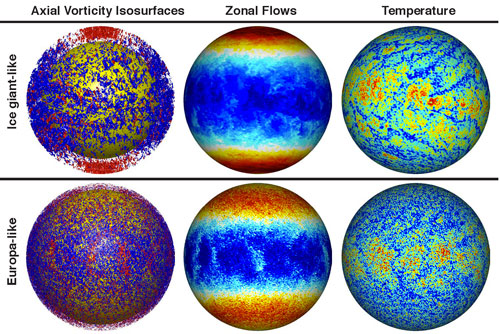Convective Dynamics in the Interiors
of Ice Giants and Icy Satellites
By:
Krista Soderlund
UTIG
| When: | Friday, March 21, 2014, 10:30 a.m. to 11:30 a.m. Join us for coffee beginning at 10:00 a.m. |
| Where: | Seminar Conference Room, 10100 Burnet Road, Bldg 196-ROC, Austin, Texas 78758 |
| Host: | Joe MacGregor, UTIG |
Click for a Live Broadcast.

Abstract
Rotating convection is ubiquitous across the solar system and responsible for a wide range of phenomena, including planetary magnetic fields, atmospheric winds, and ocean currents. Here I will focus on the internal dynamics of ice giants and icy satellites.
The ice giant planets, Uranus and Neptune, have magnetic fields, atmospheric circulation patterns, and thermal emissions that are distinct from other planets in our solar system. However, no self-consistent model has been able to reproduce all of these observations. We hypothesize that the magnetic fields and surface winds are dynamically coupled and argue that their characteristics are a consequence of quasi-three-dimensional convective turbulence. I will present dynamo models that, in agreement with observations, generate multipolar magnetic fields, produce three east-west jets, and predict local equatorial peaks in internal heat fluxes. Thus, we argue that convection weakly constrained by rotation can explain the first-order geophysical observations of the ice giants.
The icy Jovian satellite Europa maintains a global liquid water ocean between a lower silicate mantle and an upper ice shell. We use state-of-the-art rotating convection theory to predict that Europa's ocean is characterized by quasi-three-dimensional convective turbulence, similar to the interiors of Uranus and Neptune. I will present a global ocean convection model and show that large-scale currents are organized into three east-west jets and two equatorial Hadley-like circulation cells. These motions transmit the satellite's internal heat most effectively in the equatorial region, which can directly influence the latitudinal thermo-compositional state and structure of the ice shell. This heterogeneity may promote the formation of chaos features, regions of disrupted ice that occur more prevalently at low latitudes, through increased melting of the ice shell near the equator and subsequent deposition of marine ice.




